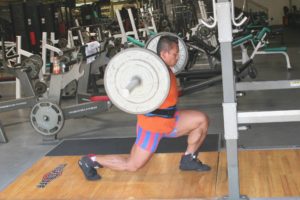
By Strength Sensei CP
Publication Date: 2000
Squats are the single best exercise for adding mass to the legs, no question. That said, I have seen many of my sprinters, jumpers, and bobsledders add inches to their already muscular legs by supplementing their squatting workouts with split squats.
Split squats are a mass builder for the quads, but also work the glutes, hamstrings, adductors, and even the calves. They also provide plenty of leg growth stimulus on days when your lower back needs a break from heavy squatting and deadlifting.
I often prescribe split squats to help my athletes achieve structural balance, such that the strength of each muscle is relatively balanced to avoid putting excessive stress on the joints and connective tissues. One example is the strength of the quads versus hamstrings.
If the strength of the quads is relatively stronger than the hamstrings, the risk of knee injuries increases. In season, my alpine skiers can easily maintain or increase their quad strength with one training session a week due to the stress their sport places on these muscles. However, to maintain or increase their hamstring strength to prevent structural imbalance, they needed at least two training sessions per week. Further, I would often have to put my skiers on a hamstring specialization program to maintain the optimal quad-to-hamstring strength ratio.
To be clear, the difference between a split squat and a lunge is that during the concentric portion of a lunge, you explode back to an upright position. With the split squat, you use a stationary stance to go up and down on the forward leg. An analogy would be the lunge functions like an escalator, and the split squat functions like an elevator.
Here is how to perform split squats with a barbell properly:
Starting Position Setup
- Stand facing away from a barbell placed on a squat rack.
- Using your index fingers, set up a reference point on the bar (use the knurling to determine the width of the grip).
- The index fingers should be as close as possible to the outside of the shoulders.
- Duck under the bar and place the bar on the thick area of the trapezius muscle.
- The chin should be slightly up.
• Focus your eyes at a point on the opposing wall that’s slightly higher than the eye to maintain proper neck alignment.
• Feet should be shoulder-width apart.
• Take a big step directly forward with your non-dominant leg to reach the initial starting position.
Descent
- The front knee moves directly forward maximally before the hips are lowered.
- The hips are then lowered, keeping the back as erect as possible and the chest up.
- The body is lowered under control until the hamstrings come in contact with the calves.
- There should be a conscious effort to keep the elbows under the bar throughout the movement. This will ensure that the load is kept as close as possible over the center of gravity.
- The knee should be traveling forward and over the toes throughout the descent.
- The athlete should inhale through the mouth throughout the descent.
Ascent
- The athlete should first raise the hips.
• The torso should remain as perpendicular to the floor as possible, particularly at the sticking point.
• The athlete should exhale throughout the ascent.
Important Points
- Trunk should be as erect as possible throughout the movement.
- Keep the eccentric lowering under control.
- Do not lean forward.

Jay Culter’s remarkable leg development helped him earn four Mr. Olympia titles. (All photos by Miloš Šarčev)
The barbell split squat is just one variation of this exercise. To change the resistance curve on this movement, you can hold dumbbells, position the barbell on the traps, keep the barbell on the clavicles using a front squat grip, or hold a single handle hooked to a low pulley using the contralateral hand. You can also elevate the front leg to increase the range of motion.
Split squats provide plenty of leg growth stimulus on days where you may want to overload the spine by squatting or deadlifting. Keep squatting, but be sure to add some split squats to your exercise toolbox.
